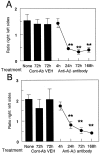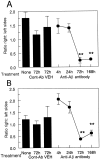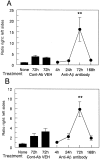Intracranially administered anti-Abeta antibodies reduce beta-amyloid deposition by mechanisms both independent of and associated with microglial activation
- PMID: 12736345
- PMCID: PMC6742181
- DOI: 10.1523/JNEUROSCI.23-09-03745.2003
Intracranially administered anti-Abeta antibodies reduce beta-amyloid deposition by mechanisms both independent of and associated with microglial activation
Abstract
Active immunization against the beta-amyloid peptide (Alphabeta) with vaccines or passive immunization with systemic monoclonal anti-Abeta antibodies reduces amyloid deposition and improves cognition in APP transgenic mice. In this report, intracranial administration of anti-Alphabeta antibodies into frontal cortex and hippocampus of Tg2576 transgenic APP mice is described. The antibody injection resulted initially in a broad distribution of staining for the antibody, which diminished over 7 d. Although no loss of immunostaining for deposited Abeta was apparent at 4 hr, a dramatic reduction in the Alphabeta load was discernible at 24 hr and was maintained at 3 and 7 d. A reduction in the thioflavine-S-positive compact plaque load was delayed until 3 d, at which time microglial activation also became apparent. At 1 week after the injection, microglial activation returned to control levels, whereas Alphabeta and thioflavine-S staining remained reduced. The results from this study suggest a two-phase mechanism of anti-Alphabeta antibody action. The first phase occurs between 4 and 24 hr, clears primarily diffuse Alphabeta deposits, and is not associated with observable microglial activation. The second phase occurs between 1 and 3 d, is responsible for clearance of compact amyloid deposits, and is associated with microglial activation. The results are discussed in the context of other studies identifying coincident microglial activation and amyloid removal in APP transgenic animals.
Figures










Similar articles
-
Microglial activation and beta -amyloid deposit reduction caused by a nitric oxide-releasing nonsteroidal anti-inflammatory drug in amyloid precursor protein plus presenilin-1 transgenic mice.J Neurosci. 2002 Mar 15;22(6):2246-54. doi: 10.1523/JNEUROSCI.22-06-02246.2002. J Neurosci. 2002. PMID: 11896164 Free PMC article.
-
Passive amyloid immunotherapy clears amyloid and transiently activates microglia in a transgenic mouse model of amyloid deposition.J Neurosci. 2004 Jul 7;24(27):6144-51. doi: 10.1523/JNEUROSCI.1090-04.2004. J Neurosci. 2004. PMID: 15240806 Free PMC article.
-
Effect of age on the duration and extent of amyloid plaque reduction and microglial activation after injection of anti-Abeta antibody into the third ventricle of TgCRND8 mice.J Neurosci Res. 2004 Dec 1;78(5):732-41. doi: 10.1002/jnr.20298. J Neurosci Res. 2004. PMID: 15478192
-
The role of microglia in antibody-mediated clearance of amyloid-beta from the brain.CNS Neurol Disord Drug Targets. 2009 Mar;8(1):7-15. doi: 10.2174/187152709787601821. CNS Neurol Disord Drug Targets. 2009. PMID: 19275633 Review.
-
Critical issues for successful immunotherapy in Alzheimer's disease: development of biomarkers and methods for early detection and intervention.CNS Neurol Disord Drug Targets. 2009 Apr;8(2):144-59. doi: 10.2174/187152709787847324. CNS Neurol Disord Drug Targets. 2009. PMID: 19355934 Free PMC article. Review.
Cited by
-
Alzheimer's Disease Animal Models: Elucidation of Biomarkers and Therapeutic Approaches for Cognitive Impairment.Int J Mol Sci. 2021 May 24;22(11):5549. doi: 10.3390/ijms22115549. Int J Mol Sci. 2021. PMID: 34074018 Free PMC article. Review.
-
Nasal vaccination with a proteosome-based adjuvant and glatiramer acetate clears beta-amyloid in a mouse model of Alzheimer disease.J Clin Invest. 2005 Sep;115(9):2423-33. doi: 10.1172/JCI23241. Epub 2005 Aug 11. J Clin Invest. 2005. PMID: 16100572 Free PMC article.
-
Intracranial administration of deglycosylated C-terminal-specific anti-Abeta antibody efficiently clears amyloid plaques without activating microglia in amyloid-depositing transgenic mice.J Neuroinflammation. 2006 May 10;3:11. doi: 10.1186/1742-2094-3-11. J Neuroinflammation. 2006. PMID: 16686956 Free PMC article.
-
Anti-pyroglutamate-3 Aβ immunotherapy engages microglia and inhibits amyloid accumulation in transgenic mouse models of Aβ amyloidosis.Acta Neuropathol. 2025 Jun 2;149(1):55. doi: 10.1007/s00401-025-02892-5. Acta Neuropathol. 2025. PMID: 40455292 Free PMC article.
-
APOLLOE4 Phase 3 study of oral ALZ-801/valiltramiprosate in APOE ε4/ε4 homozygotes with early Alzheimer's disease: Trial design and baseline characteristics.Alzheimers Dement (N Y). 2024 Aug 13;10(3):e12498. doi: 10.1002/trc2.12498. eCollection 2024 Jul-Sep. Alzheimers Dement (N Y). 2024. PMID: 39144121 Free PMC article.
References
-
- Bacskai BJ, Kajdasz ST, Christie RH, Carter C, Games D, Seubert P, Schenk D, Hyman BT. Imaging of amyloid-beta deposits in brains of living mice permits direct observation of clearance of plaques with immunotherapy. Nat Med. 2001;7:369–372. - PubMed
-
- Bard F, Cannon C, Barbour R, Burke RL, Games D, Grajeda H, Guido T, Hu K, Huang J, Johnson-Wood K, Khan K, Kholodenko D, Lee M, Lieberberg I, Motter R, Nguyen M, Soriano F, Vasquez N, Weiss K, Welch B. Peripherally administered antibodies against amyloid β-peptide enter the central nervous system and reduce pathology in a mouse model of Alzheimer's disease. Nat Med. 2000;6:916–919. - PubMed
-
- Chapman PF, White GL, Jones MW, Cooper-Blacketer D, Marshall VJ, Irizarry M, Younkin L, Good MA, Bliss TVP, Hyman BT, Younkin SG, Hsiao KK. Impaired synaptic plasticity and learning in aged amyloid precursor protein transgenic mice. Nat Neurosci. 1999;2:271–276. - PubMed
Publication types
MeSH terms
Substances
Grants and funding
LinkOut - more resources
Full Text Sources
Other Literature Sources
Medical
